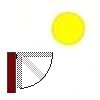ruiz.manuel94
New Member
- Joined
- Nov 16, 2021
- Messages
- 22
Hi there, I know another newbie that wants solar in his van and has no clue...
In reality, I have done a lot of research but am having a little trouble putting all the information together to decide what components to buy, since apparently everything is interconnected and I have to make all the decisions simultaneously, so I would love to hear from some of you because I am lost.
Note: My van used to be an ambulance, and it already has an inverter, and I don´t know the specs of it since they are not printed on it.
MY DESIRED SYSTEM OVERVIEW:
-LiFePO4 DIY battery (Only thing I actually have, 4s 12V 230 ah)
-Solar charging
-Shore charging
-120V AC loads:
-12 V DC loads:
BMS: What max current BMS do I need? what I know:
-Separate port BMS have low charging max current, but that is okay since apparently you can connect the battery directly to the MPPT charger, according to something I read around here. But is this also true for the shore charger?
-Discharge max current depends on the loads I plan to apply, but I am clueless about this. I guess my max load would be the fridge cycle? How to calculate current for the fridge?
-What is the current of a 600W nutribullet running on an inverter?
Panels: How many watts? (probably can only fit two standard size panels)
-Most van setups have about 200W panels. How do I calculate the current that panels will generate given their voltage and wattage?
-Should I connect them in series or in parallel?
Solar charger:
-The max voltage should be above the voltage of my panel setup
-The higher the amps the faster the charge? or more like the higher the amps the more panels I can have?
-What do we think of a charger like this one.
Shore charger:
-The larger the charger current the faster I can charge my battery. Is that right? Can I bypass the BMS?
-What is a good cheap charger?
Is there such a thing as a dual solar/shore charger? Maybe I could save a buck if such thing existed but I am guessing it doesn't
I am gonna stop there since these are already too many questions.
Would appreciate any kind of guidance.
I would like to add that I am trying to cut costs wherever possible, building the cheapest system but also ensuring it works good and is safe.
In reality, I have done a lot of research but am having a little trouble putting all the information together to decide what components to buy, since apparently everything is interconnected and I have to make all the decisions simultaneously, so I would love to hear from some of you because I am lost.
Note: My van used to be an ambulance, and it already has an inverter, and I don´t know the specs of it since they are not printed on it.
MY DESIRED SYSTEM OVERVIEW:
-LiFePO4 DIY battery (Only thing I actually have, 4s 12V 230 ah)
-Solar charging
-Shore charging
-120V AC loads:
- Tiny Mini Fridge (running from the inverter with a relay to turn it on and off using a temperature controller, like this setup )
- Charge two laptops
- 600W nutribullet (can leave this out if too expensive to include, but would be nice)
- LED lights
- Charging phones
- Small water pump
BMS: What max current BMS do I need? what I know:
-Separate port BMS have low charging max current, but that is okay since apparently you can connect the battery directly to the MPPT charger, according to something I read around here. But is this also true for the shore charger?
-Discharge max current depends on the loads I plan to apply, but I am clueless about this. I guess my max load would be the fridge cycle? How to calculate current for the fridge?
-What is the current of a 600W nutribullet running on an inverter?
Panels: How many watts? (probably can only fit two standard size panels)
-Most van setups have about 200W panels. How do I calculate the current that panels will generate given their voltage and wattage?
-Should I connect them in series or in parallel?
Solar charger:
-The max voltage should be above the voltage of my panel setup
-The higher the amps the faster the charge? or more like the higher the amps the more panels I can have?
-What do we think of a charger like this one.
Shore charger:
-The larger the charger current the faster I can charge my battery. Is that right? Can I bypass the BMS?
-What is a good cheap charger?
Is there such a thing as a dual solar/shore charger? Maybe I could save a buck if such thing existed but I am guessing it doesn't
I am gonna stop there since these are already too many questions.
Would appreciate any kind of guidance.
I would like to add that I am trying to cut costs wherever possible, building the cheapest system but also ensuring it works good and is safe.





